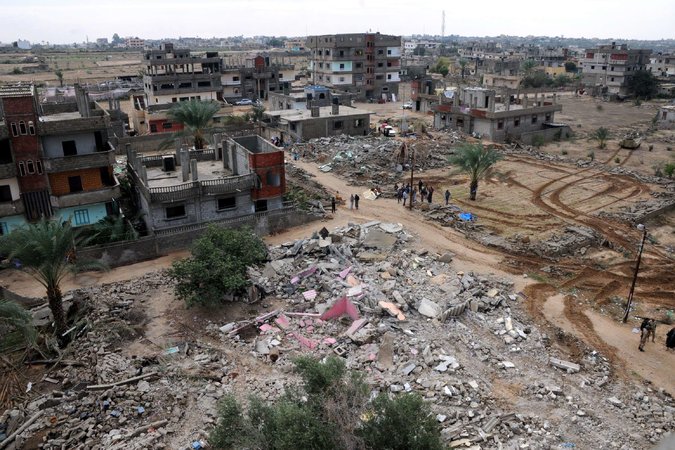
Destruction in Rafah during the Egyptian operation in November 2014.
Egyptian authorities have begun implementing phase two in the flattening of large swaths of Rafah where over 2,000 families live, and the widening of the buffer zone between the Egyptian border town and the Gaza Strip.
According to Egyptian reports, the second phase involves destroying everything standing across an additional 500 meters from the border area, on top of the 500 meters already cleared several months ago. Some 1,220 homes and structures housing 2,044 families will be demolished, after nearly 800 homes and buildings were demolished in the first phase. Egypt announced it was setting up the buffer zone after 30 Egyptian soldiers were killed and dozens more wounded in an October 24 suicide bombing.
Both sides of the border are densely populated as the city of Rafah originally extended in both directions, a growth that was the result of the Israeli occupation of the Sinai Peninsula for more than a decade following the 1967 war. In the early 2000s Israeli authorities demolished thousands of homes in Palestinian Rafah in order to create a 300-meter buffer zone on the Egypt border, but after the pull-out in 2005, many moved back into the area.
The Egyptian government,which has actively destroyed smuggling tunnels underneath the border and directly targeted Hamas since a military coup in summer 2013, has now promised to uproot as many as possible to ensure the creation of a buffer zone on its side. The border area used to be host to hundreds of tunnels which Gazans used to import goods to get around the seven-year-old Israeli siege of the territory.
The governor of northern Sinai, Abdel-Fattah Harhour over the weekend even said that the buffer zone would require evacuating all of Rafah. But he stressed that a new city would be built for the residents. The Egyptian government is slated to pay compensation to the residents based on the size of their homes, but not for their farmland. According to Harhour, the families will get 1,500 Egyptian pounds (around $210) to rent alternative accommodations until the compensation comes through.
Local observers, however, say the number of people to be evacuated will be considerably higher because many of the area’s residents are not listed in official records. Mahmoud Barhoum, a local journalist, said many families have been evacuated to farms outside the area of the buffer zone because they haven’t received compensation, and that in any case it is very difficult to find affordable homes for rent.
Hassan al-Nahlawi, a northern Sinai social activist, said most Rafah residents are heading to the populated areas of Al-Arish and other villages along the northern Sinai coast. Nahlawi described the situation as a humanitarian crisis, noting that families whose homes are not actually in the planned buffer zone are also being forced out because of the military activity in the area. Those families have gotten no help or compensation from the government at all, and are living in camps west of Al-Arish.


.jpg)


No comments:
Post a Comment